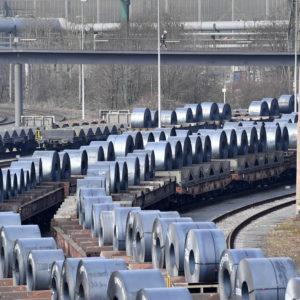The steel industry is booming thanks to a red-hot economy, but if the trade war continues and economists are right about an impending economic downturn, then steel — and other industrial sectors — could be in red-hot trouble.
RapidRatings, which evaluates companies’ financial health and rates them on a scale of 0-100 (100 being the financially healthiest rating), just released new data showing trouble ahead for the steel industry.
Right now, the U.S. steel industry as a whole is seeing wider profit margins thanks to tariffs. This year alone, net profit margins jumped from 3.5 percent in Q1 2019 to 4.3 percent in Q2 2019 (although this isn’t considered a remarkable jump for the steel industry).
But the costs of raw materials in the steel industry are surging: since Q4 2018, iron ore prices skyrocketed a whopping 68 percent. While business is good for iron ore mining firms, those costs are trickling down the supply chain to steel mills, fabricators and welders.
Because of increasing materials costs, the financial health of U.S. companies throughout the steel supply chain is already starting to weaken.
The global average financial health rating (FHR) for steel companies across the supply chain clocked in at a troublesome 51 in Q2 2019, down from 55 at the end of fiscal year 2018. Because U.S. steel companies still rely on non-U.S. companies throughout their supply chains, weak links in the supply chain will eventually catch up to U.S. companies.
“As global supply chains continue to destabilize, the costs of supplier failure are universally felt,” RapidRatings said in their steel industry report. “Our data shows that poor financial health increases the likelihood of problematic supplier performance.”
At the end of fiscal year 2018, U.S. steel companies and their major importers from Canada and Mexico maintained a decent average FHR of 66. But in Q2 2019, the average dropped to 63.
For U.S.-only companies, the average FHR at the end of fiscal year 2018 was 69, and in Q2 2019 it dropped to 68, which suggests that tariffs and trade tensions between the U.S., Canada and Mexico could end up hurting U.S. companies and workers, especially if Congress doesn’t approve the United States Canada Mexico Agreement (USMCA) soon.
With a potential economic downturn on the horizon, U.S. steel companies could be facing big problems when it comes to funding.
“I think many of these companies are going to have more difficult funding over the next couple years than the last three years,” RapidRatings CEO James Gellert told InsideSources. “For many of these companies, their credit ratings span the high investment to the medium grade. Their access to capital will be dependent on how bullish and aggressive the cusp B grade line investors are.”
According to Bloomberg, big banks like J.P. Morgan are already prepping for an economic downturn by moving workers out of New York City to cut costs.
The Federal Reserve Bank of Philadelphia predicts that seven key 2020 states — six of which voted for Trump in 2016 — will face an economic contraction through March 2020. Two of those states — Michigan and Ohio — are top steel industry states.
That doesn’t bode well for the U.S. steel industry, nor for Trump’s chances at reelection in 2020.
“Companies that have bonds to refinance in the next couple years may find it harder to refinance that debt than it was to issue that debt initially,” Gellert said. “This isn’t unique to steel, it’s a challenge across industries. But industries that have deteriorating quality overall and are dependent on markets for their core product and their sales that are in turn affected by a downturn in the economy, they’re the ones that will be affected faster, and that includes steel.”
The U.S.-imposed steel tariffs have been in effect for less than two years, so it’s difficult to conclude any net negative or positive effects at this point, but factors like a slowing economy and surging raw materials costs signal trouble for steel.
“I think they’re all going to be affected by lower steel prices, tariffs, and questions about demand over the next couple of years [in the event of an economic downturn],” Gellert said. “The ones that are weaker will have a more difficult time in the capital markets.”

